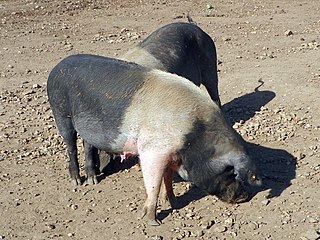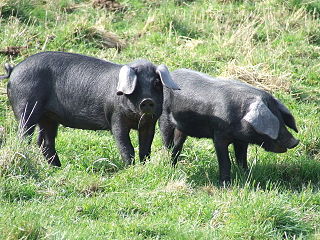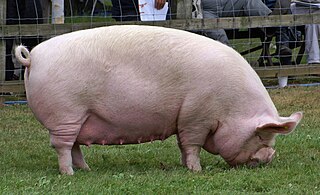 W
WThe Berkshire is a British breed of pig. It originated in the English county of Berkshire. It has been exported to a number of countries including Australia, Japan, New Zealand and the United States. It is mainly black, usually with some white on the snout and on the lower legs.
 W
WThe British Landrace is a British domestic breed of pig and one of the most popular in the United Kingdom. It is white with heavy drooping ears that cover most of the face and is bred for pork and bacon. The breed originated in the 1949 importation of 12 landrace pigs from Scandinavia — four boars and eight gilts. In 1950, the British Landrace Pig Society was formed and it opened a herd book for the first offspring born from the imported 12. They created the first pig testing scheme with a testing station at the village of Stockton-on-the-Forest in North Yorkshire.
 W
WThe British Lop is an old pig breed native to the United Kingdom. A large, white pig, it is named for its large ears which hang over its face. The breed was originally developed as an amalgamation of several local lop-eared breeds in England, and came to be known as the British Lop in the 1960s.
 W
WThe British Saddleback is a modern British breed of domestic pig. It was created in 1967 by merging the surviving populations of two traditional saddleback breeds, the Essex and Wessex Saddleback.
 W
WThe Essex is a breed of domestic pig originating in the United Kingdom.
 W
WThe Gloucestershire Old Spots is an English breed of pig which is predominantly white with black spots. It is named after the county of Gloucestershire. The Gloucestershire Old Spots pig is known for its docility, intelligence, and prolificity. Boars reach a mature weight of 600 lb (272 kg) and sows 500 lb (227 kg). The pigs are white with clearly defined black spots. There must be at least one spot on the body to be accepted in the registry. The breed's maternal skills enable it to raise large litters of piglets on pasture. Its disposition and self‑sufficiency should make it attractive for farmers raising pasture pigs and those who want to add pigs to diversified operations.
 W
WThe Large Black pig is a British breed of domestic pig. It is the only British pig that is entirely black. It was created in the last years of the nineteenth century by merging the black pig populations of Devon and Cornwall in the south-west with those of Essex, Suffolk and Kent in the south-east. It is hardy, docile and prolific; it forages well and is suitable for extensive farming, but not well suited to intensive management.
 W
WThe Large White is a British breed of domestic pig. It derives from the old Yorkshire breed from the county of Yorkshire, in northern England.
 W
WThe Middle White is a breed of domestic pig native to the United Kingdom. It originated in Yorkshire roughly around the same time as the Large White. Its name comes from the fact that it was between the size of the Large White and the now-extinct Small White. It was fully recognized as a breed in 1884. The breed is known as a pork producer, and is best known for its sharply upturned snub nose. It is docile and often kept outdoors in grazing situations. Though its numbers have rebounded somewhat, the breed is listed as endangered by the Rare Breeds Survival Trust.
 W
WThe Oxford Sandy and Black is a breed of domestic pig originating in Oxfordshire. Named for its colour, which is a base of sandy brown with black patches, the breed is also sometimes called the "Plum Pudding" or "Oxford Forest pig." Related to the old Berkshire and Tamworth breeds, it is one of the oldest pigs native to Britain.
 W
WThe Tamworth, also known as Sandy Back and Tam, is a breed of domestic pig originating in its namesake Tamworth, Staffordshire United Kingdom, with input from Irish pigs. It is among the oldest of pig breeds, but as with many older breeds of livestock, it is not well suited to modern production methods and is listed as "Threatened" in the United States and "Vulnerable" in the UK by the Rare Breeds Survival Trust, as fewer than 300 registered breeding females remain. This animal is of ginger to red colouration and is thought to have descended from wild boars, via native pig stock of Europe. Principal populations today are in the United Kingdom, Australia, the United States, New Zealand, and Canada.
 W
WThe Wessex Saddleback or Wessex Pig is a breed of domestic pig originating in the West Country of England, (Wessex), especially in Wiltshire and the New Forest area of Hampshire. It is black, with white forequarters. In Britain it was amalgamated with the Essex pig to form the British Saddleback, and it is extinct as a separate breed in Britain. However, the Wessex Saddleback survives in Australia and New Zealand.